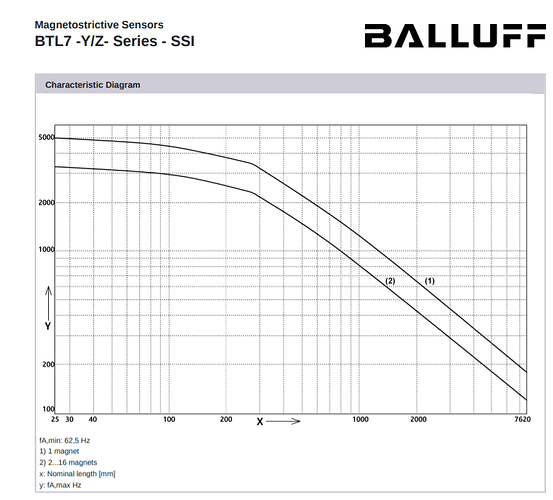Hi all,
I’m looking for theoretical advice on encoders and the pros and cons.
I’ve been sent a data sheet for a BTL5 which seems to suggest that the SSI version internaly samples the position at only 400Hz whereas the 4-20ma equivalent has lower resolution (7um vs 1um) but its position can be read much much faster.
So i’m intrigued as to what is more important, resolution vs number of samples per second. taking into account ssi vs analogue signals with potential noise.
Thanks
Pete
That’s curious. I would like to see that datasheet. I understand that the BTL5 sensors in general can update up to 1500 Hz, but it’s dependent on length, as it is with all magnetostrictive sensors, and that doesn’t differ between analog and SSI, as far as I know.
We always recommend SSI, and it’s important to specify the synchronous option. With analog, the sensor’s interrogation isn’t synchronized with the RMC, which results in jitter. Analog is also lower resolution by the specs, and the analog signal itself is usually much more susceptible to noise, resulting in even less effective resolution.
-Jacob
Note, most of the Balluff line is now in the BTL7 series of transducer. Perhaps the explosion proof and hygienic designs are still BTL5.
A common part number for a transducer embedded into a cylinder would be.
BTL7-S501B-Mxxxx-Z-S115
where xxxx is the sensing length in mm (i.e. 12 in → M0305)
The S501 signifies SSI, 24 bit binary rising, 1 micron resolution
The B signifies synchronous operation (VERY IMPORTANT W/ RMC’s)
The Z signifies 3/4" O-Ring interface to the cylinder
The S115 signifies 8 conductor M12 connector connection
I believe the internal sensing parts are all common so the low level measurement characteristics are all similar but how that measurement is triggered, gated and transmitted differ and can affect the control of the axis. And, as Jacob said, the max update is dependent on length. For a single magnet, max is 5kHz but at my example 12 in length it’s still a respectable 3kHz.
